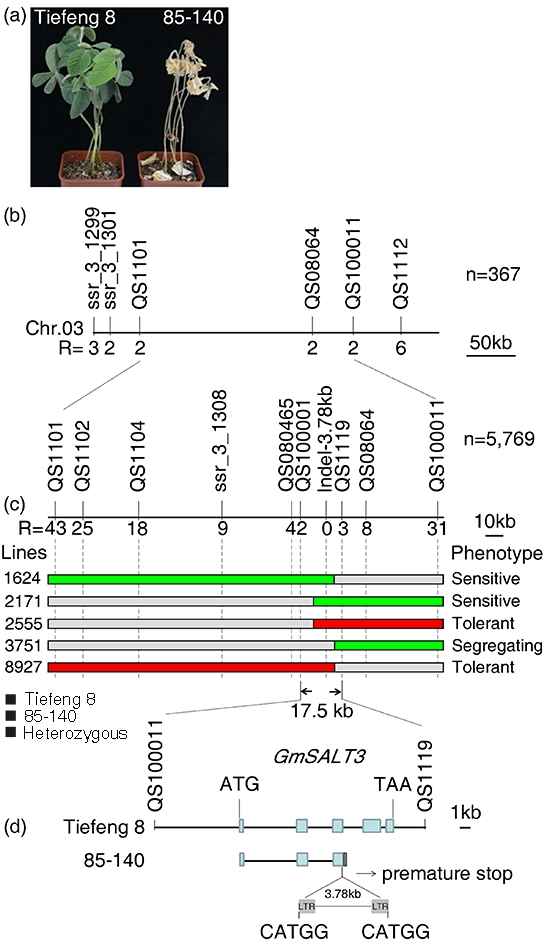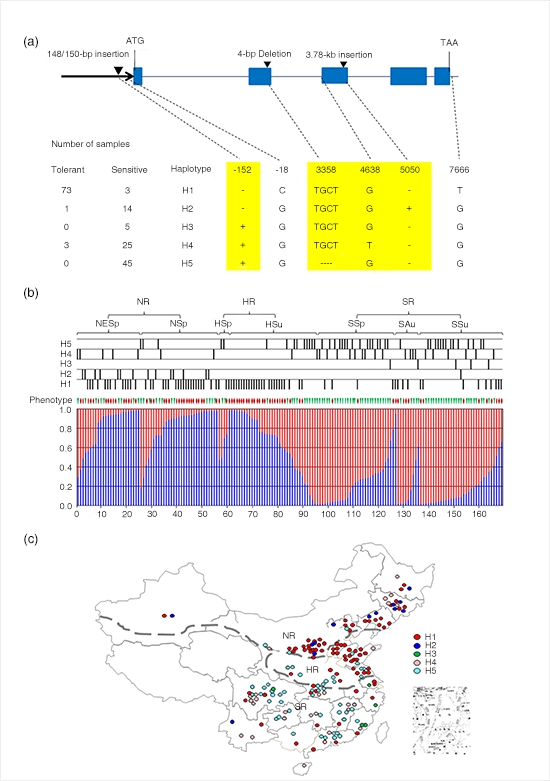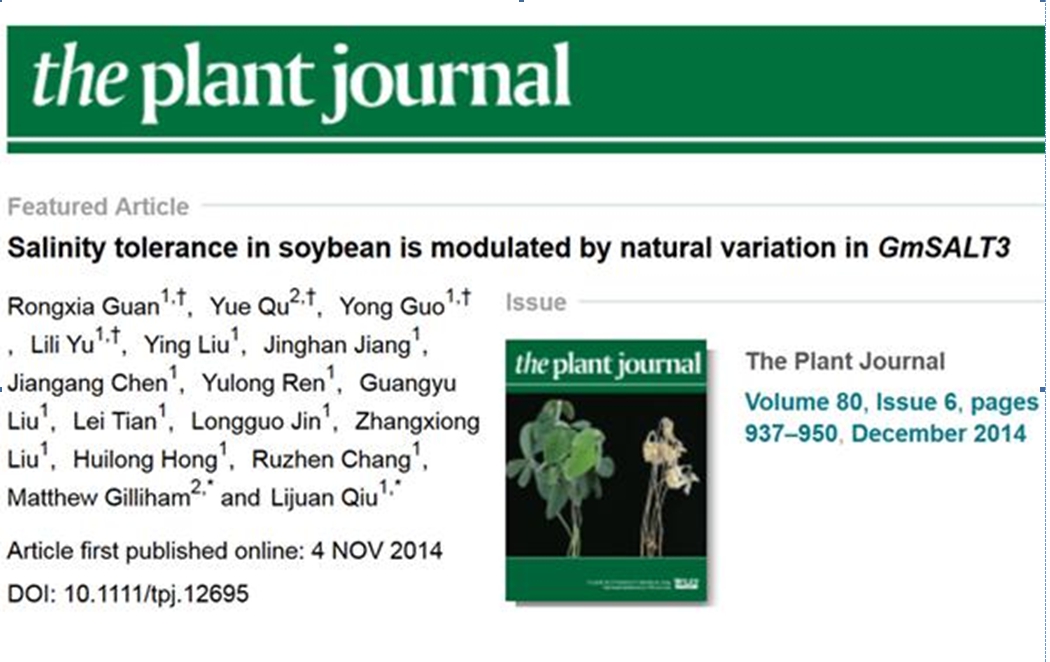分享到
CAAS Found a New Soy Source for Crop Salt Tolerance
A collaborative research project between Chinese and Australian scientists has shown how soybean can be bred to better tolerate soil salinity.
The salt-affected agriculture land is rapidly increasing and predicted to double by 2050. Many commercial crops are sensitive to soil salinity and this can cause major losses to crop yields. An increase in the salt tolerance of crops will be effective for improving crop productivity and food security in the condition of expanding the area of agricultural land.
It was reported that the salt tolerance in soybean is controlled by a single dominant allele Ncl nearly half century ago. A major QTL related to soybean salt tolerance was mapped and validated on chromosome 3 by different research groups, but no information of positional cloning of this important locus was found.
In the past decade, with examining the genetic sequence of several hundred soybeans, research led by Prof. Lijuan Qiu at the ICS of CAAS pinpointed a candidate salt tolerance gene, and then collaborating with Assoc. Prof. Matthew Gilliham’s team at the ARC Centre of Excellence in Plant Energy Biology, University of Adelaide, further characterized the function of this gene.
“We initially identified the gene by comparing two commercial cultivars so we were both surprised and pleased to see that this gene also conferred salt tolerance in some other commercial cultivars, old domesticated soybeans and even wild soybeans; it appears that this gene was lost when breeding new cultivars of soybean in areas without salinity, which has left many new cultivars susceptible to the rapid increases that we are currently seeing in soil salinity around the world”, said Prof. Qiu.
By identifying the gene, genetic markers can now be used in breeding programs to ensure that salt tolerance can be maintained in future cultivars of soybean that will be grown in areas prone to soil salinity.


Talking about the future prospects of this research, Assoc. Prof. Gilliham added, “This gene functions in a completely new way from other salt tolerance genes we know about. Efforts are still ongoing to discover mechanism underlying GmSALT3 protein. We are excited about using this information to find similar genes in different crops such as wheat and grapevine, to selectively breed for their enhanced salt tolerance”.
The findings are published as a featured article in The Plant Journal in December, 2014. The co-first authors are Associate Prof. Rongxia Guan, Mr. Yue Qu, Associate Prof Yong Guo, and Ms. LiLi Yu, and the corresponding authors are Prof. Lijuan Qiu and Assoc. Prof Matthew Gilliham.
The article is highlighted on The Plant Journal's home page and available for free download for one month from the day of online publication.
To download the free article, please click:
http://onlinelibrary.wiley.com/doi/10.1111/tpj.12695/abstract

The salt-affected agriculture land is rapidly increasing and predicted to double by 2050. Many commercial crops are sensitive to soil salinity and this can cause major losses to crop yields. An increase in the salt tolerance of crops will be effective for improving crop productivity and food security in the condition of expanding the area of agricultural land.
It was reported that the salt tolerance in soybean is controlled by a single dominant allele Ncl nearly half century ago. A major QTL related to soybean salt tolerance was mapped and validated on chromosome 3 by different research groups, but no information of positional cloning of this important locus was found.
In the past decade, with examining the genetic sequence of several hundred soybeans, research led by Prof. Lijuan Qiu at the ICS of CAAS pinpointed a candidate salt tolerance gene, and then collaborating with Assoc. Prof. Matthew Gilliham’s team at the ARC Centre of Excellence in Plant Energy Biology, University of Adelaide, further characterized the function of this gene.
“We initially identified the gene by comparing two commercial cultivars so we were both surprised and pleased to see that this gene also conferred salt tolerance in some other commercial cultivars, old domesticated soybeans and even wild soybeans; it appears that this gene was lost when breeding new cultivars of soybean in areas without salinity, which has left many new cultivars susceptible to the rapid increases that we are currently seeing in soil salinity around the world”, said Prof. Qiu.
By identifying the gene, genetic markers can now be used in breeding programs to ensure that salt tolerance can be maintained in future cultivars of soybean that will be grown in areas prone to soil salinity.


Talking about the future prospects of this research, Assoc. Prof. Gilliham added, “This gene functions in a completely new way from other salt tolerance genes we know about. Efforts are still ongoing to discover mechanism underlying GmSALT3 protein. We are excited about using this information to find similar genes in different crops such as wheat and grapevine, to selectively breed for their enhanced salt tolerance”.
The findings are published as a featured article in The Plant Journal in December, 2014. The co-first authors are Associate Prof. Rongxia Guan, Mr. Yue Qu, Associate Prof Yong Guo, and Ms. LiLi Yu, and the corresponding authors are Prof. Lijuan Qiu and Assoc. Prof Matthew Gilliham.
The article is highlighted on The Plant Journal's home page and available for free download for one month from the day of online publication.
To download the free article, please click:
http://onlinelibrary.wiley.com/doi/10.1111/tpj.12695/abstract

Latest News
-
 Apr 18, 2024Opening Ceremony of the Training Workshop on Wheat Head Scab Resistance Breeding and Pest Control in Africa Held in CAAS
Apr 18, 2024Opening Ceremony of the Training Workshop on Wheat Head Scab Resistance Breeding and Pest Control in Africa Held in CAAS -
 Apr 03, 2024IPPCAAS Co-organized the Training Workshop on Management and Application of Biopesticides in Nepal
Apr 03, 2024IPPCAAS Co-organized the Training Workshop on Management and Application of Biopesticides in Nepal -
 Mar 28, 2024Delegation from the School of Agriculture and Food Science of University College Dublin, Ireland Visit to IAS, CAAS
Mar 28, 2024Delegation from the School of Agriculture and Food Science of University College Dublin, Ireland Visit to IAS, CAAS -
 Mar 25, 2024Director of World Food Prize Foundation visited GSCAAS
Mar 25, 2024Director of World Food Prize Foundation visited GSCAAS -
 Mar 20, 2024Institute of Crop Sciences (ICS) and Syngenta Group Global Seeds Advance Collaborative Research in the Seed Industry
Mar 20, 2024Institute of Crop Sciences (ICS) and Syngenta Group Global Seeds Advance Collaborative Research in the Seed Industry
